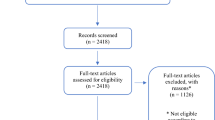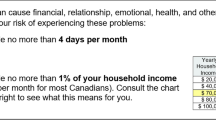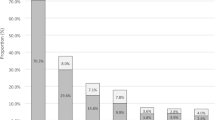Abstract
An increase in prevalence of problem gambling and gambling-related costs to the individual, family, and community are accompanying the spreading availability of venues in which to gamble. This highlights the need for effective educational programs, media campaigns, consumer protection, and public policy aimed at preventing increased incidence of problematic gambling behavior. This review explores prominent models of prevention including the risk and protective factors model, levels-of-prevention, and the public health perspective and illustrates each model’s power to facilitate efforts toward preventing gambling problems. The current state of problem gambling prevention research and practice is delineated and future directions for policy are made. Editors’ Strategic Implications: Researchers and policymakers will benefit from the review and set of recommendations and also the detailed supplemental online content, in the form of six helpful Appendixes related to gambling prevention resources and materials.

Similar content being viewed by others
Notes
A list of appendixes can be found in Table 1. The appendixes are available on The Journal of Primary Prevention website, linked to this article, at http://www.springerlink.com/content/0278-095X.
References
Abbott, M. W., Williams, M., & Volberg, R. A. (2004). A prospective study of problem and regular non-problem gamblers living in the community. Substance Use and Misuse, 39, 855–884.
American Gaming Association. (2002). Statutes and regulations in commercial casino states concerning responsible gaming. Available at http://americangaming.org.
American Gaming Association. (2003). Code of conduct for responsible gaming. Retrieved on April 27, 2007 from http://www.americangaming.org/programs/responsiblegaming/code_public.cfm.
American Psychological Association, Public Policy Office. (June, 2004). APA briefing sheet. Retrieved October 02, 2006 from http://www.apa.org/ppo/issues/preventionbrf604.html.
Arnold, G., Collins, P., Eadington, W. R., Remeers, P., & Ricketts, T. (March, 2003). Towards a strategy for addressing problem gambling in the UK. A Report to the Gambling Industry Charitable Trust. Retrieved April 27, 2007 from http://www.rigt.org.uk/downloads/towards_a_strategy_report_chapter_1.pdf.
Bellringer, M. E., Perese, L., Rossen, F., Tse, S., Adams, P., Brown, R., & Manaia, W. (2003). Supporting the wellbeing of young people in relation to gambling in New Zealand: Final report and recommendations. Retrieved April 27, 2007 from http://www.health.auckland.ac.nz/population-health/gambling-studies/res_pubs.html.
Blaszczynski, A. (2001). Harm minimization strategies in gambling: An overview of international initiatives and interventions. Melbourne: Australian Gaming Council.
Bournstein, P. J., Zweig, J. M., & Gardner, S. E. (1999). Understanding substance abuse prevention: Toward the 21st century: A primer on effective programs. Rockville, MD: Department of Health and Human Services, Substance Abuse and Mental Health Services Administration, Center for Substance Abuse Prevention, Division of Knowledge Development and Evaluation.
Browne, B. A., & Brown, D. J. (1993). Predictors of lottery gambling among American college students. Journal of Social Psychology, 134, 339–347.
Caplan, G. (1964). Principles of preventive psychiatry. New York, NY: Basic Books.
Consumer Contact. (2003). Testing of harm minimization messages for gambling machines. Report for the department of gaming and racing. Sydney: Author.
Derevensky, J. L., Gupta, R., Dickson, L. & Deguire, A.-E. (2001). Prevention efforts toward reducing gambling problems. White Paper prepared for the Substance Abuse and Mental Health Services Administration.
Derevensky, J., Gupta, R., & Emond, M. (1995, August). Locus of control, video game playing, and gambling behavior in children. Poster presented at the annual meeting of the American Psychological Association, New York, NY.
Dickson, L., Derevensky, J., & Gupta, R. (2002). The prevention of youth gambling problems: A conceptual model. Journal of Gambling Studies, 18, 97–159.
Dickson, L., Derevensky, J., & Gupta, R. (2004). Harm-reduction for the prevention of youth gambling problems and other high-risk behaviors. Journal of Adolescent Research, 19, 88–128.
Diskin, K. M., & Hodgins, D. C. (1999). Narrowing of attention and dissociation in pathological video lottery gamblers. Journal of Gambling Studies, 15, 17–28.
Fisher, S. (1993). Gambling and pathological gambling in adolescents. Journal of Gambling Studies, 9, 277–288.
GamCare. (2003). GamCare care services report. London: National Association for Gambling Care, Educational Resources and Training.
Griffiths, M. (1995). Adolescent gambling. London: Routledge.
Griffiths, M., Scarfe, A., & Bellringer, P. (1999). The UK national telephone gambling helpline: Results on the first year of operation. Journal of Gambling Studies, 15, 83–90.
Gupta, R., & Derevensky, J. (1997). Familial and social influences on juvenile gambling. Journal of Gambling Studies, 13, 179–192.
Gupta, R., & Derevensky, J. (1998). Adolescent gambling behavior: A prevalence study and examination of the correlates associated with excessive gambling. Journal of Gambling Studies, 14, 319–345.
Hardoon, K., & Derevensky, J. (2002). Child and adolescent gambling behavior: Our current knowledge. Clinical Child Psychology and Psychiatry, 7, 263–281.
Hardoon, K., Gupta, R., & Derevensky, J. (2004). Psychosocial variables associated with adolescent gambling. Psychology of Addictive Behaviors, 18, 170–179.
Hodgins, D. C., & el-Guebaly, N. (2000). Natural and treatment-assisted recovery from gambling problems: A comparison of resolved and active gamblers. Addiction, 95, 777–789.
Hodgins, D. C., Wynne, H., & Makarchuk, K. (1999). Pathways to recovery from gambling problems: Follow-up from a general population survey. Journal of Gambling Studies, 15, 93–104.
Independent Pricing, Regulatory Tribunal. (2004). Gambling: Promoting a culture of responsibility. Sydney: Independent Pricing and Regulatory Tribunal of New South Wales.
Institute of Medicine. (1994). Reducing risks for mental disorders: Frontiers for prevention intervention research. Washington, DC: National Academy Press.
Jackson, A., Thomas, S., & Blaszczynski, A. (2003). Best practice in problem gambling services. Retrieved on April 27, 2007 from http://www.grp.vic.gov.au/.
Jackson, A., Thomas, S. A., Thomason, N., & Ho, W. (2002). Longitudinal evaluation of the effectiveness of problem gambling counselling services, community education strategies, and information products. Vol. 3: Community education strategies and information products. Melbourne: Victoria Department of Human Services.
Korn, D., & Shaffer, H. (1999). Gambling and the health of the public: Adopting a public health perspective. Journal of Gambling Studies, 15, 289–365.
Korn, D., Gibbins, R., & Azmier, J. (2003). Framing public policy towards a public health paradigm for gambling. Journal of Gambling Studies, 19, 235–256.
Ladouceur, R., Jacques, C., Giroux, I, Ferland, F., & Leblond, J. (2000). Analysis of a casino’s self-exclusion program. Journal of Gambling Studies, 16, 453–460.
Ladouceur, R., Vitaro, F., Cote, M. A., & Dumont, M. (2001). Parents’ attitudes, knowledge, and behavior toward gambling: A five year follow-up. Journal of Gambling Studies, 17, 101–116.
Ladouceur, R., Vezina, L., Jacques, C., & Ferland, F. (2000). Does a brochure about pathological gambling provide new information? Journal of Gambling Studies, 16, 103–108.
Langhinrichsen-Rohling, J., Rohde, P., Seeley, J., & Rohling, M. (2004). Individual, family, and peer correlates of adolescent gambling. Journal of Gambling Studies, 20, 23–46.
Messerlian, C., Derevensky, J., & Gupta, R. (2005). Youth gambling problems: a public health perspective. Health Promotion International, 20, 69–79.
Moore, T., Jadlos, T., & Carlson, M. (2000, May). Findings and recommendations for the strategic plan: Identification, prevention, and treatment of disordered gambling in Multnomah County. Portland, OR: Behavioral Health Division, Multnomah County.
Moore, T. L. & Marotta, J. J. (2004). Gambling treatment programs evaluation update, 2003. Report prepared for the State of Oregon Mental Health and Addictions Services Department of Human Services. Retrieved on April 27, 2007 from http://www.gamblingaddiction.org/STATE2002/ORGAMEVAL02.pdf.
Moran-Cooper, M., Kruedelbach, N. & Biller, W. (2003). From helpline inquiry to completed clinical assessment: Proactive strategies to turn callers to clients. Paper presented at the National Conference on Problem Gambling, Louisville, KY.
Mullally, K. (2004). Self-exclusion guidelines: Report of the sel- exclusion committee to the board of the National council on problem gambling. Washington, DC: National Council on Problem Gambling.
Najavits, L. M., Grymala, L. D., & George, B. (2003). Can advertising increase awareness of problem gambling? A statewide survey of impact. Psychology of Addictive Behaviors, 17, 324–327.
National Council on Problem Gambling, American Gaming Association, & North American Association of State, Provincial Lotteries. (1999). 1998 national survey of problem gambling programs. Washington, DC: National Council on Problem Gambling.
National Opinion Research Center (NORC). (1999). Gambling impact and behavior study: Report to the National Gambling Impact Study Commission. Chicago, IL: National Opinion Research Center at the University of Chicago.
National Research Council. (1999). Pathological gambling: A critical review. Washington, DC: National Academy Press.
Petry, N., Armentano, C., Kuoch, T., Norinth, T., & Smith, L. (2003). Gambling participation and problems among South East Asian refugees to the United States. Psychiatric Services, 54, 1142–1148.
Raylu, N., & Oei, T. (2004). Role of culture in gambling and problem gambling. Clinical Psychology Review, 23, 1087–1114.
Shaffer, H. J., & Hall, M. N. (2001). Updating and refining meta-analytic prevalence estimates of disordered gambling behavior in the United States and Canada. Canadian Journal of Public Health, 92, 168–172.
Shaffer, H. J., & Hall, M. N. (2002). The natural history of gambling and drinking problems among casino employees. Journal of Social Psychology, 142, 405–424.
Slutske, W. S., Jackson, K. M., & Sher, K. J. (2003). The natural history of problem gambling from age 18 to 29. Journal of Abnormal Psychology, 112, 263–274.
South Australian Centre for Economic Studies. (2003, February). Evaluation of self-exclusion programs. Report prepared for the Gambling Research Panel. Victoria, AU: Author.
Thomas, S. A., & Jackson, A. C. (2001). Longitudinal evaluation of the effectiveness of problem gambling counselling services, community education strategies and information products. Vol. 6. Project discussion paper. Melbourne: Victorian Department of Human Services. Retrieved April 27, 2007 from http://www.problemgambling.vic.gov.au.
Tremblay, R. E., Masse, L. C., Vitaro, F., & Dobkin, P. L. (1995). The impact of friend’s delinquent behavior on early onset delinquency: Longitudinal data from 6 to 13 years of age. Development and Psychopathology, 7, 649–667.
Victoria Department of Human Services. (2001). Strike against problem gambling. Retrieved July 27, 2007 from http://www.dhs.vic.gov.au/humanservicesnews/mar01/localdru.htm.
Victoria Department of Human Services. (2003). Annual report, 2002–2003. Retrieved April 27, 2007 from http://www.dhs.vic.gov.au/annrep/ar0203/dhs_annrep_03.pdf.
Vitaro, F., Brendgen, M., Ladouceur, R., & Tremblay, R. (2001). Gambling, delinquency, and drug use during adolescence: Mutual influences and common risk factors. Journal of Gambling Studies, 17, 171–190.
Vitaro, F., Ferland, F., Jacques, C., & Ladouceur, R. (1998). Gambling, substance use, and impulsivity during adolescence. Psychology of Addictive Behaviors, 12, 185–194.
Volberg, R. A. (1994). The prevalence and demographics of pathological gamblers: Implications for public health. American Journal of Public Health, 84, 237–241.
Volberg, R. A. (2003). Paying the piper: Gambling and problem gambling in America. In G. Reith. (Ed.), Gambling: Who wins? Who loses? (pp. 221–238). Amherst, NY: Prometheus Books.
Wallisch, L. S. (1998). Problem gambling helplines nationwide. Austin, TX: Texas Commission on Alcohol and Drug Abuse.
Wear Simmons, C. (2006). Gambling in the golden state 1998 forward. Sacramento, CA: California Research Bureau.
Wiebe, J., Cox, B., & Falkowski-Ham, A. (2003). Psychological and social factors associated with problem gambling in Ontario: A one-year follow-up study. Retrieved April 27, 2007 from http://www.gamblingresearch.org/contentdetail.sz?cid=2690.
Winters, K. C., Bengston, P. L., & Stinchfield, R. D. (1996). Findings from a follow-up study of callers to the Minnesota problem gambling hotline. Minneapolis, MN: University of Minnesota.
Winters, K. C., Stinchfield, R. D., & Fulkerson, J. (1993). Patterns and characteristics of adolescent gambling. Journal of Gambling Studies, 9, 371–386.
Wood, R., & Griffths, M. (1998). The acquisition, development and maintenance of lottery and scratchcard gambling in adolescence. Journal of Adolescence, 21, 265–272.
Wood, R. T. A., & Griffiths, M. D. (2001). Adolescent gambling on The National Lottery: Attitude formation and related psychosocial factors. Social Psychology Review, 3, 48–56.
Wynne, H. J., Smith, G. J., & Jacobs, D. F. (1996). Adolescent gambling and problem gambling in Alberta. Edmonton, AB: Alberta Alcohol and Drug Abuse Commission.
Wynne, H. J., Smith, G. J., & Volberg, R. A. (1994). Gambling and problem gambling in Alberta report prepared for Alberta lotteries and gaming. Edmonton, Alberta: Authors.
Zimmerman, M. A., Meeland, T., & Krug, S. E. (1985). Measurement and structure of pathological gambling behavior. Journal of Personality Assessment, 49, 76–81.
Author information
Authors and Affiliations
Corresponding author
Electronic supplementary material
Rights and permissions
About this article
Cite this article
Dickson-Gillespie, L., Rugle, L., Rosenthal, R. et al. Preventing the Incidence and Harm of Gambling Problems. J Primary Prevent 29, 37–55 (2008). https://doi.org/10.1007/s10935-008-0126-z
Published:
Issue Date:
DOI: https://doi.org/10.1007/s10935-008-0126-z




